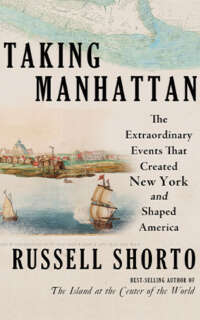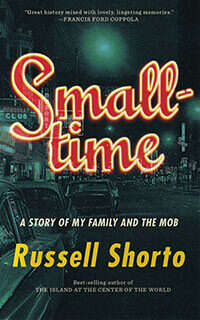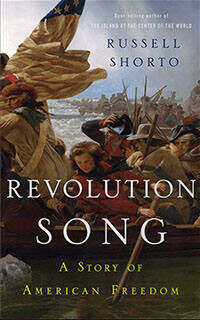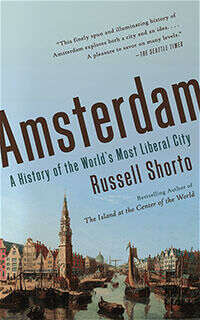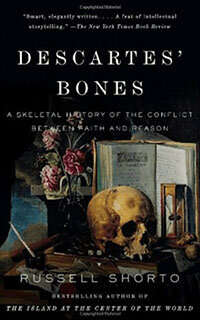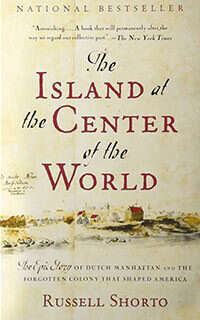All Political Ideas Are Local
The New York Times
by Russell Shorto
October 02, 2005
In January 1861, as Southern states were in the process of seceding from the union, Fernando Wood, the mayor of New York, made a modest proposal to his city council. New Yorkers – whose city profited from the shipping of Southern cotton – weren’t crazy about the idea of a civil war. Wood’s idea was that if the South severed its ties to the United States, New York should, too. Under his plan, the city would refashion itself into “a free city” called Tri-Insula – comprising Manhattan, Staten Island and Long Island – which would do business with both the North and South as they fought each other, thus sidestepping carnage and substituting business sense for patriotic fervor.
Tri-Insula never happened, but Americans have always tended to treat New York as if it had. The “it feels like a foreign country” line is a standard souvenir that visitors from other parts of the nation take home with them. New York is different – both literally and metaphorically insular. And, for more than a generation, it has been far from the center of American politics. It once held sway over the national political scene, but there hasn’t been a New Yorker in the White House since F.D.R., and as the state drifted downward in relative population since 1970 – after being the most populous state from the 1820’s through the 1960’s, it is now third and ranks 46th in rate of population growth – political wisdom came to hold that electable presidential contenders should hail from the South or the West. Sure, New York has power, it has money, it has restaurants that top their dishes with wasabi foam, but that makes the point, doesn’t it? To McMansion-dwelling exurbanites driving their Yukons down the interstate to the local big-box store, Manhattan is airy and unreal, more of a jazz-age stage set than somewhere they’d go in search of real-world political ideas or leaders who know their meat-and-potatoes concerns.
Strange, then, that in recent presidential-preference polls for 2008, Americans’ top choices include New York’s junior senator, Hillary Clinton, and the city’s former mayor Rudy Giuliani. Granted, such polls taken three years out are lousy predictors (in 2001, one poll had John Kerry, the Democratic nominee in 2004, ranked fifth among would-be Democratic candidates, with around 3 percent support); but they are barometers of the moment in which they are taken. Toss in the fact that Gov. George Pataki, who has ruled out running for a fourth term, popped up at an Iowa county fair this year – an indicator of presidential ambitions – and you have the makings of an anomaly.
So what does it mean? Possibly, nothing. The crowd of potential New York candidates is easy enough to explain away: Giuliani’s nationwide strength derives from the prominence that 9⁄11 gave him, Pataki hopes for some of the same and Clinton is a one-of-a-kind figure. But on closer inspection, these factors relate back to New York’s uniqueness: the World Trade Center was attacked because of what New York is and represents, and the former first lady surely chose New York as her base for similar reasons.
This brings up a further set of questions. What is it that New York had in its glory days – when it fostered political ideas and programs that transformed the nation – and does it still have it? Is New York today just an archetype of bigness and brashness, or is there something in its culture – and therefore in its political culture – that the country needs? Put simply: Is New York relevant?
One way to approach these questions – which also happens to get at some of the political tensions roiling the country today – is by going back to the beginning. American politics is not a monolith that burst into being with a few pen flourishes in 1776. Rather, you could think of it as springing from two sources, each of which flows back to the earliest stratum of the country’s existence. There is the dominant one – call it American – and the subordinate one, which we may think of as the New York source.
The American strain, which has soared triumphant in recent years, is overtly and unashamedly moralistic. It comes straight out of the Puritans who settled New England. The Puritans’ worldview was theological to the core: Europe was corrupt and despoiled; the New World was the Promised Land. As their venture began to succeed, the Puritans believed that success to be a sign of God’s favor. They were “the new Israel,” the chosen people. When the first American history books were written in the 1660’s – by the sons of the first Puritan and Pilgrim leaders – they laid this theological template onto the American saga, and succeeding generations adopted it. Many of the founding fathers believed that God was guiding their hands as they signed the Declaration of Independence and the Constitution. In the 19th century the Puritans’ exceptionalism was reframed as manifest destiny: the notion that Americans had, as the journalist John O’Sullivan put it when he coined the phrase, the right “to overspread the continent allotted by Providence for the free development of our yearly multiplying millions.”
After World War I, President Woodrow Wilson took the manifest-destiny concept global as he proclaimed his belief that the United States had “seen visions that other nations have not seen” and had become not only “a determining factor in the history of mankind” but, echoing the gospel of Matthew, “the light of the world.” President Bush hewed to the same theme as he pressed to invade Iraq. “We go forward with confidence, because this call of history has come to the right country,” he said in his third State of the Union address. “The liberty we prize is not America’s gift to the world; it is God’s gift to humanity.” The straight-up claim to a religious basis for the entire national project has always been a source of tremendous strength for the U.S., and for a leader who can evoke it convincingly it is even better than wrapping yourself in the flag. It’s a magic button that rallies popular support around the holy trinity: God, America, liberty.
Then there is New York. Somehow, New York has never played along with this morality play. On the contrary, its lowlife image hangs on in the American consciousness – corruption- and chaos-ridden, the scabby home base of all the world’s hustlers and scammers – never mind the layers of gentrification and Disneyfication. The image extends to politics as well. “Ungovernable” is the adjective that has been endlessly applied to New York City, from the Tammany Hall days to John Lindsay’s wobbly Vietnam-era mayoralty, through blackouts and riots, from Son of Sam to the squeegee guys.
In many ways it’s a fair cop. But the conundrum is that New York is also, historically, the fertile soil from which some of the richest ideas and policies have been harvested, ideas and policies that have defined the relationship between the American people and their government.
Why is this the case? When the first political parties in America burst into being in the 1730’s, with colonists deciding that it would be a good idea to form an organized opposition to their British rulers, why did it happen in New York? Why was it that the notion of a free press was first articulated, in 1735, in the case of a New York printer, John Peter Zenger? How is it that New York played a crucial role in developing both the concept of the government protecting the environment (Theodore Roosevelt carrying to the White House ideas of land conservation that developed during his governorship) and also – when Franklin Roosevelt took from Albany to Washington policies that would be the basis of the New Deal – the concept of the government protecting people from the darkest chasms of fate and corporate greed? Kenneth Jackson and David Dunbar, in the introduction to “Empire City,” their excellent anthology of New York writings, ask, “Is it a coincidence that the American Communist Party, the National Association for the Advancement of Colored People and the gay rights movement all started in the city?” No, it isn’t, and to that list you could add both liberalism and the modern conservative movement.
All of these disparate political forces and innovations have behind them a single theme: factions. America is a pluralistic nation, but its founding was largely an English affair. The exception is New York: or, to be precise, the Dutch colony of New Netherland, which stretched across the Middle Atlantic, between New England and Virginia, and had as its capital New Amsterdam. The Dutch colony was one of the most culturally mixed places on earth in the 17th century – by one account, 18 languages were being spoken in the streets of New Amsterdam at a time when its total population was perhaps 500 – and this diversity provided the stock for New York’s ethnic stew. Factionalism being the essence of politics, New York thus had in its founding the ingredients to make it the nation’s laboratory of political ideas.
They also proved to be ingredients for long-term antipathy. While Anglo-American colonists were adopting the worldview of the New England Puritans as their own, they were already looking askance at New York. “Our chiefest unhappyness here is too great a mixture of nations, and English ye least part,” wrote a British officer who was posted to Manhattan in 1692, 28 years after New Amsterdam became New York. Plenty of people have echoed his remarks. Even Peter Stuyvesant – the last director of New Netherland and the first in a long line of blustery and domineering figures to loom over New York’s political landscape – wrote to one governor of the New England colonies that he envied them their pure societies and complained that his own population was made up of the “scrapings” of different nations. Even internally, even before it was New York, New York had an image problem.
Related to that is an identity problem, which stems in part from New York’s duality. While there is certainly a well-entrenched Big Apple identity, “there is no New York State identity to correspond with, say, the pride a Texan has for Texas,” says Peter Eisenstadt, editor of the newly published Encyclopedia of New York State, a monumental volume he says he hopes will help foster a statewide identity. Upstate residents look at the city from more or less the same distance as people from other states, and the schism has only grown in recent years, as the city has become richer and parts of the state have languished.
To talk about image and identity isn’t to suggest that the association of New York politics with corruption is just a question of bad P.R. But the matter requires some unpacking. You could make a case that the central figure in New York’s political history, the individual who served as the conduit into which the complex forces arising out of its mixed immigrant founding in the 17th century were channeled and from whom they issued forth to shape the modern political landscape, was not one of the city’s celebrated mayors (La Guardia or Walker or Wagner or O’Dwyer) or one of the influential governors (Teddy Roosevelt, F.D.R., Thomas Dewey) or any of the other revered figures in the state’s long political history, from Alexander Hamilton to Daniel Patrick Moynihan, but that personification of political corruption, William Magear (Boss) Tweed. He stood as a colossus in 19th-century America, his physical magnitude (he weighed in at 300 pounds) matching that of his power and fraud. At the height of his power, around 1870, when he reigned as boss of both Tammany Hall and the Democratic Party, Tweed controlled the governor, local judges and much of Wall Street and the press. So puppetlike was New York’s mayor, Abraham Oakey Hall, that Tweed once held a special vote to re-elect him without bothering to tell the man. At the street level, meanwhile, Tweed guaranteed outcomes by organizing armies of repeat voters among the poor, who proudly referred to themselves as “Tweed’s repeaters.”
It was New York’s dense immigrant society that spawned Tweed’s vast web of organized corruption. And yet, at the same time, this human symbol of the political dark side was also a node in the march of American political achievement and reform. The scope of Tweed’s graft obscures what were obvious facts in immigrant ghettos of 1800’s New York: in an era when there was no social safety net, Tweed filled not only a moral vacuum but also a human one, providing jobs and financing hospitals, schools and orphanages. His initiatives, including widening Broadway and chartering the Metropolitan Museum of Art, meant employment for thousands of immigrants. As Kenneth Ackerman puts it in his new biography, “Boss Tweed,” the elements of “Tweed’s style of running a political party – rigorous organization, ethnic inclusion and tough discipline – became staples of big-city machines for a century, fitting the lofty theories of democratic government to the rough realities of life.”
But Leo Hershkowitz, a historian and another Tweed biographer, sees something even greater embedded within Tweed’s substantial persona. Tweed himself was a force of nature, probably operating from no greater underlying personal philosophy than his fellow Tammany boss George Washington Plunkitt, who crisply summed up his approach to politics with the line “I seen my opportunities and I took ’em.” But in bringing the poor immigrant masses of New York into the political system (albeit for personal gain), Tweed was also pointing to the future and seriously upset the genteel oligarchy that held sway in the New York of the era. “That’s why they went after Tweed,” Hershkowitz says, referring to the coalition of politicians, businessmen and media forces (including The New York Times) that finally brought him down. “The people in power wanted to maintain what they had. They were afraid of what was coming. The fight wasn’t against Tweed as much as against the idea of government actually becoming democratic.” Like a cowboy breaking in a wild horse, Tweed rode social forces that had grown since the first immigrants arrived, and if he didn’t exactly tame them, he brought them into the corral.
Meanwhile, one of the lawyers who tangled with Tweed, Attorney General Charles Fairchild, went on to become U.S. treasury secretary, and the boss’s other nemesis, the lawyer-then-governor Samuel Tilden, parlayed his anti-corruption fame into national politics, losing the presidency to Rutherford B. Hayes despite winning the popular vote, in the infamous election of 1876. So also out of the murk of that era comes the New York tradition of tort-slinging celebrity prosecutors – Rudy Giuliani and Eliot Spitzer among the latest practitioners – with their eyes equally on rooting out corruption and fanning their own ambition.
*
On March 25, 1911, a sweatshop on Washington Square called the Triangle Shirtwaist Company went up in flames. It’s hard to appreciate today the combination of shock and resolve with which New Yorkers greeted news of this event, which killed 146 workers, most of them young Jewish and Italian women. But the reactions – a spontaneous half-million-person march and a sudden mass determination to make the law protect workers – were primed by the earlier era of ad hoc bossism reigning over the immigrant hordes. The fire sparked a hundred political careers and changed the country. Alfred E. Smith came out of the Tammany Hall political machine, but in the post-Tweed era, and especially after the fire, he pulled it in the direction of progressive reform. When Smith became governor in 1918, Belle Moskowitz, who had been involved in the state’s investigation of the fire, led Smith’s push for laws related to housing, health care and workplace protections, and so vast was the yearning for these reforms that she became, by some reckonings, the most powerful woman in America. Another reformer, Frances Perkins, who went on to serve under Smith in Albany and then became President Franklin Roosevelt’s secretary of labor, later claimed that the New Deal arose from the ashes of the factory fire.
You could draw a line, then, from Stuyvesant’s pluralistic Dutch port city to Tweed’s street-smart control of immigrant groups in post-Civil War New York to F.D.R., the New Deal and the whole edifice of modern liberalism. But it would probably be off base to think that this division of the country’s political legacy into two strains has a neat correlation with the major parties of today, with Republicans following the Puritan line and Democrats in the New York camp. True, Democrats have, since the New Deal, played the part of representatives of minority interests, and New York has been a Democratic bastion since F.D.R.’s day. And in recent years Republicans have certainly sung the “God Bless America” theme for all they’re worth. But, lest we forget, liberalism wasn’t always anathema to Republicans. “One of the remarkable things about liberalism in New York State is that after World War II, it was basically Republican-led,” says Peter Eisenstadt. “You had 12 years of Dewey and 16 years of Rockefeller. It was both Democrats and Republicans who shaped the progressive era of New York.”
Beyond this, the New York strain of influence speaks to something more than liberal-versus-conservative. You could argue that the modern conservative movement had its birth in New York. It’s where William F. Buckley Jr. founded National Review in 1955, and where, in the 1970’s, Irving Kristol, Norman Podhoretz and other New York intellectuals brought forth neoconservatism. Such forms of conservatism arose in reaction to what some felt were misguided excesses of midcentury liberalism, which was found most fully developed in New York City itself. Fiorello La Guardia’s terms as mayor coincided almost exactly with F.D.R.’s presidency, and although a Republican, he made New York into New Deal City. The result, in the conservative view – a paternalistic and entrenched municipal government of massive proportions, balkanized to serve a thousand interest groups, devouring taxes and federal monies at an elephantine rate while its infrastructure rotted – became a test case for their theories.
Buckley’s 1965 campaign for mayor amounted to a first airing of ideas that would later become conservative stock in trade. Later, the Manhattan Institute developed as a policy center for intellectuals – many of them disaffected liberals – who wanted to incinerate the welfare-state concept and dance on its ashes. The Manhattan Institute and its publication, City Journal, bred or developed many of the ideas – most famously the “broken windows” approach to policing – that Giuliani enacted during his time as mayor. In the view of the historian Fred Siegel, expressed in his new biography of Giuliani, “The Prince of the City,” Giuliani’s achievement was not that he was “America’s mayor” in the days following 9⁄11 but that he “saved the city from its own, apparently intractable, political pathologies.”
Looked at in this way, liberalism isn’t New York’s contribution to the nation but one manifestation of the New York strain of influence, which is constantly evolving in a dialectical pattern, the success (or failure) of one idea leading to its own collapse and then to a new thesis. People have tried to define the New York essence in any number of ways. It has something to do with the racial and ethnic tangle. It has to do with talk, chatter, tension, strife, street fighting, barrios, gangs, bosses, bare knuckles. It has to do with the scrum of ideas. It has to do with a certain density of souls, with vertical living, with the inherent limitations of an island, its shoreline functioning like the rim of a pot.
Out of this mix a new politics was forged, and, beneath it, an approach to morality that came to be seen as secular, unfettered by religious ideology. The intellectuals and workers who formed the American Communist Party in New York in 1919, on the heels of the Russian Revolution, were ideologues committed to a vision that was based on firm moral principles but had nothing to do with God. Exactly half a century later, when the gay rights movement came into being following a police raid on the Stonewall Inn in Greenwich Village, you might say that it, too, formed around principles of secular morality.
Maybe this is the root of the historic tension between the country’s two political traditions. The Puritan one, hogging the high moral ground, encamped in its shining city on a hill, has always despised the rowdy and godless gangs of New York. The us-them divide that conservative Christians maintain holds that, historically, they have Christian morality on their side while others have only their Enlightenment gods of science and reason. And some of their opponents like to believe this as well.
But it’s a false divide. Both the Puritans who settled New England and who bequeathed to American politics much of their dogma, and the Dutch founders of New York based their societies on Christian principles. They just had different approaches to theology. The Puritans were more typical of their era, when religious intolerance was official policy in most nations. (It’s true the Puritans themselves fled intolerance, but once they established themselves in America, they set up their own brutally intolerant régime.) Dutch Protestants, however, had experienced horrific violence at the hands of the Spanish Inquisition, and many had had enough of religious absolutism. Tolerance became codified into Dutch law, and Dutch cities, which had high concentrations of minorities, flourished. As a result, when the Dutch founded their New World colony centered on Manhattan Island, it, too, was a mixed society, and it, too, had as its social glue this notion of tolerance.
The point is that tolerance was at the time seen most fundamentally as a theological issue. The Puritans’ righteousness came from the conviction – common to all absolutists – that their faith was the only correct one, so that God compelled them to uphold it and to vanquish others. Those who argued for tolerance did so from a more humble, but equally theological, stance. In the words of one early advocate of tolerance, “Many will be damned on Judgment Day because they killed innocent people, but nobody will be damned because he killed nobody.”
Looking all the way back, then, New York’s mixed society, and with it America’s, owes its origins not to accident or geography but at least in part to a Christian conviction, won by the experience of slaughter and mayhem, that we – whoever we are at the moment – may not be smart enough to know God’s mind. The unlikeliest notion in the world therefore follows: that New York’s cultural mosh pit is built on a foundation of humility.
The attacks of 9⁄11, with their apocalyptic overtones, were pure protein for the Puritan impulse, with its conviction of America’s God-ordained role in history. Those who would stand up to the Puritan strain, which many people believe has reached the stage of posing an unprecedented danger, might want to exploit the fact that their tradition, just as much as the Puritans’, sits on a religious foundation. Pluralism and morality aren’t two separate things but are joined, and it’s from that juncture that much of what we call American comes. After Frances Perkins served as F.D.R.’s secretary of labor, she was able to say, referring to the New Deal, “I came to Washington to work for God, F.D.R. and the millions of forgotten, plain, common working men.” Nobody saw a conflict of interest.
What’s wrong with this argument – this division of American political history into Puritan and New York streams – is not that it overplays New York’s significance but that, if anything, it squeezes it into too narrow a channel. New York’s influence has been seen as gritty and urban and muscular, but New York was also at the forefront of the second Great Awakening, the country’s mass 19th-century religious revival, predecessor of today’s evangelical movement. And when he coined the term manifest destiny, John O’Sullivan was working as an editor in…New York. The fact is that, in the universe of ideas, geography isn’t fixed. What we are talking about is something that entered America in a particular locality but has long since flowed throughout the land and psyche. It would be absurd to think that the next figure to represent the American pluralistic tradition – to articulate both its positive stance and its outrage over Puritan excesses – would have to be someone who has held a political office in New York, or had an address there, or even visited. We are talking about history, and history isn’t “the past” so much as the past as it has flowed into the present. For as James Baldwin once put it, “People are trapped in history, and history is trapped in them.”
Then, too, New York, in its continual processing of new immigrant groups, tends to remain what it was at the beginning and thus stays a source of both fear and hope. The demographic fears that Tweed stirred – that “we” are about to be engulfed by “them” – are alive and well, not only in New York but also throughout the country. We all have, somewhere within, a lowercase puritan who wants to hold the barbarians outside the gate, keep things as they are or return them to an imagined state of grace.
If New York still has an important contribution to make to the national political dialogue, it surely has to do with the fact that it has, in this sense, remained as it always was. Kenneth Jackson put it to me this way: “People always fear that the city is about to become a minority city. A hundred years ago the fear was that it would become Italian or Irish. But what happens is ‘they’ become ‘us.’ Americanness is always changing, and that tends to happen first in New York.” Giuliani once said, referring to the city’s political culture, that he wanted to make New York “more like the rest of America.” Americans may yet find themselves yearning for the opposite.
